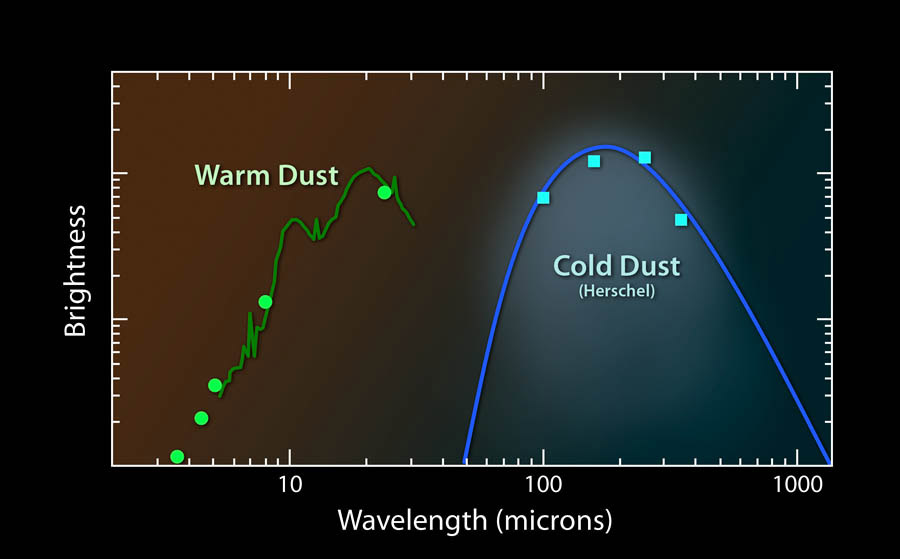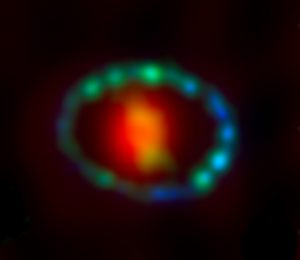| Basic Information | |
| What is this? | The region around a supernova which exploded in 1987, called SN1987A |
| Where is it in the sky? | In the Large Magellanic Cloud |
| How big is it? | The shell of matter around the star is expanding, and is around a light year across |
| How far away is it? | Around 160,000 light years |
| What do the colours represent? | The purple is the cold dust seen by Herschel, while the blue and green are the warmer dust and stars seen by Spitzer. In the inset, hot gas is shown in blue and green, while the cold gas in the centre is seen in red. |
Downloads
See this object in:
Astronomers have long suspected that exploding stars, or supernovae, are responsible for the formation of cosmic dust. The origin of this dust is important because it plays a crucial role in the formation of stars, particularly billions of years ago when star formation was at its peak. Supernovae in our own galaxy are very rare, but in 1987 astronomers were trated to one in the Large Magellanic Cloud, a small galaxy around 160,000 light years away.
The star which exploded would originally have been around 20 times the mass of the Sun, but in the later stages of its life it lost around a third of its mass into a giant cloud. Such enveloping clouds are one possible source of dust in the Universe, but can only account for a tiny fraction of what is observed. Eventually, the aging star could no longer support its own weight, and on 23rd February 1987 astronomers saw it brighten dramatically as it collapsed in a violent supernova.
The explosion resulting from a collapsing star is one of the most violent events in the Universe, and this event, called “SN1987a”, was no different. The supernova glowed with the brightness of 100 million Suns for around a month, while most of the material that made up the star was blown outwards at immense speeds. The resulting shockwave energised a ring of material in a disc of gas and dust around the star, and is still travelling outwards at speeds of up to 6000 km/s (13 million miles per hour).
The pulse of light from the supernova lit up a ring of material around a light year across (10 million million km), dozens of times the size of our own Solar System. This material glows in visible and ultraviolet light, as well as in x-rays. Small amounts of dust in the ring were warmed to a temperature of -100 Celsius, and this has previously been seen glowing faintly in infrared light.

A spectrum of SN1987a, showing the emission from the warm dust in the ring, detected by Spitzer (green), and the cold dust now seen by Herschel at much longer wavelengths (blue). The lines are the theoretical emission lines, and the points are the measurements from Spitzer and Herschel. Image credit: ESA/NASA-JPL/Caltech/UCL
Twenty three years after the initial explosion, in 2011, the Herschel Space Observatory observed the supernova remnant. As well as the warm dust in the glowing ring, the new measurements have shown that there is dust in the centre of the remnant with a temperature of below -250 Celsius, just 20 degrees above absolute zero. There is much more of this cold dust than the warm dust previously seen – in fact, enough to form more than 200,000 Earths. The wavelengths observed by Herschel are crucial to detecting this dust, as its very low temperature means that it is not detectable at other wavelengths.
“We didn’t expect to see SN1987A when we planned the survey,” explains Margaret Meixner, from the Space Telescope Science Institute in Baltimore, USA, and who leads the HERITAGE survey for which these observations were taken. “Based on our existing knowledge of dust in supernovae, we could not have anticipated that Herschel would have detected this source. It has definitely been one of the biggest surprises of our project,” she adds.
The dust was formed from material that was thrown away from the star in the initial explosion. If similar amounts are created in all such explosions, this could explain the origin of much of the dust seen in the Large Magellanic Cloud. Most of the dust found by Herschel in the form of carbon and silicates, not dissimilar to sand or quartz, though there are smaller amounts of iron present as well. The dust is probably being heated by a range of processes, either by x-rays emitted by the glowing ring, or by the radioactive decay of heavy elements, such as titanium, which were created in the star’s final moments.

The gas in the remant itself. The blue and green represent hot gas seen by Hubble, specifically iron, silicon and hydrogen, primarily in the ring around the remnant. Red shows the cold carbon monoxide seen by ALMA, which is seen in the centre.
The observations of SN1978a are crucial for understanding the remnants of supernova that Herschel is observing in our own Galaxy, which exploded hundreds or thousands of years ago. But this latest result also has much further reaching consequences. “With objects like SN1987a, we can investigate details that are almost impossible to discern in supernovae inside more distant galaxies. This helps us improve our understanding of these stellar explosions, which we can then apply to the broader context of galaxy evolution,” explained Mikako Matsuura, University College London, who led the research.
Herschel observed Supernova 1987a again in June 2012, along with ground based telescopes such as the ALMA telescope array in Chile. These observations, presented at the 2013 UK National Astronomy Meeting, confirmed that there are large quantities of cold gas in the centre of the remnant. In particular, the results showed the presence of large amounts of carbon monoxide, a relatively simple molecule which forms easily in cool regions.
The estimated quantity of gas is equivalent to around a tenth of the mass of the Sun, much more than the amounts observed directly after the explosion, a quarter of a century previously. One possible explanation is that this cold molecular gas, along with some of the cosmic dust, has continued to form after the explosion. Whatever the cause of the increase, these observations have confirmed that supernovae are one of the sources of interstellar dust.
Detailed Information
- Matsuura et al. (2011) Science 333, 1258 “Herschel detects a massive dust reservoir in
supernova 1987A” - Kamenetzky et al. (2013) Monthly Notices of Royal Astronomical Society, in press “Carbon Monoxide in the Cold Debris of Supernova 1987A”

